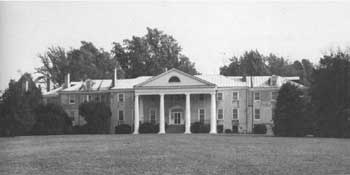







Survey of
Historic Sites and Buildings
 |
MONTPELIER Virginia |
 Montpelier |
| ||
Montpelier, or Montpellier, was James Madison's residence for nearly all his life. Born at his grandmother's home in King George County in 1751, he soon traveled with his mother to his father's farm, a tract in Orange County that had been in the family since 1723 and that became the nucleus of Montpelier. There, he first lived in a modest wooden house, constructed by his grandfather, Ambrose Madison, about two decades earlier and probably located a half mile south of the present mansion. The early, or central, portion of the present Georgian residence was constructed by his father, also named James, about 1760. When the latter died in 1801, he bequeathed the house and part of the estate to his oldest son, James.
Madison's frequent absences were mainly for education or public service. Upon completion of his second term as President, he and his wife, Dolley, retired to Montpelier. They held court for a succession of visitors, including the Marquis de Lafayette, James Monroe, Thomas Jefferson and Daniel Webster. After Madison died at Montpelier in 1836, Mrs. Madison returned to Washington, D.C., where she resided until she succumbed 13 years later. They are both buried at Montpelier.
 |
| Montpelier. (National Park Service (Contractor, Alan's Photography Studio, Culpeper, Va., 1975).) |
The mansion was originally a brick, rectangular structure, two stories in height over an elevated basement. It consisted of two large rooms and a central hall on each floor. During his first term as President, in 1809-11, Madison retained architects William Thornton and Benjamin H. Latrobe to remodel the house. The former enlarged the main building, and the latter added step-down, one-story wings. The exterior brick walls were also stuccoed. Apparently the huge Doric portico was added at a later time. In 1907 the wings were enlarged to 2-1/2 stories.
Madison, who was interested in horticulture and agriculture, planned the gardens and landscaping of the estate, which had grown to more than 1,000 acres, many of which were under cultivation. Tobacco and corn were the principal crops. During his absences, Madison left an overseer in charge.
The mansion and the beautifully landscaped grounds have been carefully maintained. Three-bay wings flank the seven-bay central section of the hip-roofed mansion. Four huge Doric columns support the two-story portico, which has a triangular pediment containing a semi-circular window. The double-door front entrance is framed by sidelights and a fanlight. A pair of chimneys stand at either end of the main building, and a chimney at the end of each wing. A dentiled cornice adorns the roofline and the pediment.
Privately owned, the estate, except for the Madison family cemetery, is not accessible to the public.
 |
 |
http://www.cr.nps.gov/history/online_books/constitution/site30.htm
Last Updated: 29-Jul-2004